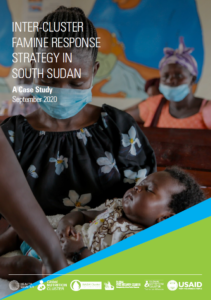Case study on the inter-cluster famine response strategy in South Sudan
The crisis in South Sudan remains complex and protracted with both acute and chronic needs experienced at varying levels across 78 counties of the country and Abyei region. Nearly 4 million people remain displaced by the humanitarian crisis: 1.5 million internally and more than 2…
 The crisis in South Sudan remains complex and protracted with both acute and chronic needs experienced at varying levels across 78 counties of the country and Abyei region. Nearly 4 million people remain displaced by the humanitarian crisis: 1.5 million internally and more than 2 million as refugees. The country remains in a critical period of unprecedented and severe food insecurity (2017-2020), with about 6 million people considered food insecure and experiencing high acute malnutrition rates regularly surpassing the emergency thresholds of 15 per cent. Lack of access to basic services and eroded capacities have weakened the resilience of already vulnerable populations. Protection issues remain of great concern with vulnerable men, women, boys and girls facing protection threats and Sexual and Gender-Based Violence (GBV).
The crisis in South Sudan remains complex and protracted with both acute and chronic needs experienced at varying levels across 78 counties of the country and Abyei region. Nearly 4 million people remain displaced by the humanitarian crisis: 1.5 million internally and more than 2 million as refugees. The country remains in a critical period of unprecedented and severe food insecurity (2017-2020), with about 6 million people considered food insecure and experiencing high acute malnutrition rates regularly surpassing the emergency thresholds of 15 per cent. Lack of access to basic services and eroded capacities have weakened the resilience of already vulnerable populations. Protection issues remain of great concern with vulnerable men, women, boys and girls facing protection threats and Sexual and Gender-Based Violence (GBV).
The recently revitalized peace process promises to offer new opportunities in the coming years for South Sudan’s women, men and children. The launch of the National Development Strategy 2018-2021, with the overall objective of consolidating peace and stabilizing the economy, echoes the peace optimism.
Although challenging, the South Sudan experience, documented in this case study, introduced a range of practices that have been further sustained. This included ensuring a joint coordination forum for partners to meet, discuss and listen to what they know and expect of integration.
These forums were also an opportunity to clarify, encourage and address concerns. Regular analyses were done during cluster meetings to track gaps alongside the commitment of partners, and to hold them accountable to agreed timeframes. Another practice that was established was the incremental use of joint assessments and joint analyses, among others. Nowadays, clusters continue to use the minimum famine response package of services, while also committing to an integrated approach in the sectoral Humanitarian Response Plans.